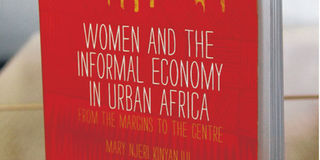Tracing financial curve of urban women, from margins to centre

Rarely have I derived as much pleasure from a book review as I have done with Mary Njeri Kinyanjui’s Women and the Informal Economy in Urban Africa: From the Margins to the Centre. PHOTO| MARTIN MUKANGU
What you need to know:
The nine-chapter study by Dr Kinyanjui, a senior research fellow at the Institute of Development Studies of the University of Nairobi, tackles a subject that has preoccupied urban researchers for decades.
The holder of a PhD in geography from the University of Cambridge walks the reader through the theories of planning and economic informality in an African city, Nairobi to be precise.
Focusing on a 30-year period (1980-2010), the book is a study in how women have overcome restrictions on mobility to shed the tag of consumers of their husbands’ economic productivity. Entrepreneurs in their own right.
Rarely have I derived as much pleasure from a book review as I have done with Mary Njeri Kinyanjui’s Women and the Informal Economy in Urban Africa: From the Margins to the Centre.
Indeed, my reviews in recent times have been more of groans over bad English and scant editing than analyses of the all-important content issues.
However, Dr Kinyanjui’s 2014 offering — an Africa Now Zed Books (London) publication — illustrates the fact that good scholarship can blend weighty contemporary issues with impeccable easy-to-read English.
The nine-chapter study by Dr Kinyanjui, a senior research fellow at the Institute of Development Studies of the University of Nairobi, tackles a subject that has preoccupied urban researchers for decades.
The holder of a PhD in geography from the University of Cambridge walks the reader through the theories of planning and economic informality in an African city, Nairobi to be precise.
Focusing on a 30-year period (1980-2010), the book is a study in how women have overcome restrictions on mobility to shed the tag of consumers of their husbands’ economic productivity. Entrepreneurs in their own right.
The study that focuses on Taveta Road has powerful testimonies of women, who chose to shed the beggar mentality and take charge of their offspring’s destinies.
The author states in the introduction that one cannot speak of the informal economy in Africa without thinking about women. “Urban markets in Nairobi, Lagos and Accra are dominated by women, who are responsible for a massive trade in food and clothes.”
While abundant literature exists to illustrate how urbanisation and urban planning have victimised Africans by condemning them to slums, street trade and the informal sector, little exists on how Africans “have configured the city through their participation in economic informality”.
The book examines the state and impact of women in economic informality in Nairobi, where, according to the Kenya National Bureau of Statistics (2011), 2.7 million people are engaged in the informal economy.
The study leans towards an urban theory that focuses on the ordinariness of cities in terms of their diversity, creativity, modernity and distinctiveness as opposed to the dominant theory that categorises cities as global, world, and developing world cities.
There is a need to investigate the diversity and creativity within the African city in terms of the indigenous market concept, solidarity entrepreneurialism, inclusion of women in urban planning, and collective organisation as a method of organising business spatially in the city centre.
While this review sidesteps issues theoretical, including the fact that women have had to deal with an urban planning ideology that excludes them, the testimonies of women, who have overcome failures in urban planning, are riveting and a study of women’s indomitable spirit.
In this regard, Chapter 6 titled: “Women in economic informality in Nairobi” is a ‘must-read’ for the myriads of urbanites, who would be doomed were it not for their mothers’ refusal to be perpetual dependants and veritable beggars from the inappropriately named breadwinners.
A woman in the study states: “Being independent... from always stretching out my hand to beg from my husband, is an indicator of my business success. I am able to pay fees for my child in a private school. I have built my own house and bought a shamba [parcel of land]... Had I stuck in my miserable job, I would not be where I am”
Food for thought: Could this explain why increasingly more young graduates are shunning employment to venture into informal business?
The author notes most women’s desire to educate their children, quoting another woman, who sees her children’s education as her first priority.
“Many people will not understand why I am paying Sh25,000 for my son’s education in kindergarten. It is because I want him to have a good start.”
The study debunks the myth that the informal sector is all about living from hand-to-mouth, having found out that 106 women — a third of the study cluster — own their business premises, while 24.2 per cent own homes.
“Some women in economic informality are also employers of labour. No less than 46 per cent or 153 of the enterprises surveyed were employing workers”— ranging from one to 12.
“This indicates that businesses are moving from owner-run entities to businesses that call for a division of labour between the owner and the employees”— a proposal borne out of the fact that the value of the businesses studied ranged between Sh2,500 to Sh5 million.
Even as Prof Kinyanjui challenges the World Bank to consult women and people in economic informality as it partners with the city county to transform the Eastlands region, I challenge storywriters out there to build on this study by collecting more powerful testimonies of these unsung heroes to inspire droves of jobless youth in Nairobi and Kenya at large.





